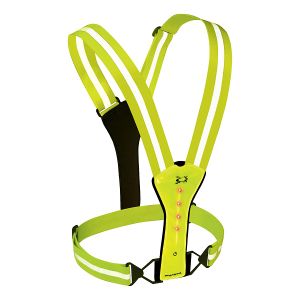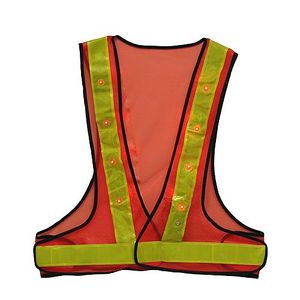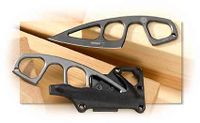Running Safety
These are some tips for safe running in an urban environment. For wilderness safety, check out Running Trails.
- Don't be ruled by fear. It's important to evaluate the real risks of any activity rather than acting out of fear or ignoring the problem due to a sense of invulnerability. People are remarkably bad at understanding risks, and tend to overreact to unfamiliar risks while ignoring the everyday. That's why people are scared of flying, but not driving.
- Think before you start. Don't wait to think about safety until you are running, but plan ahead.
- Be seen at night. The biggest risk to runners is not being attacked, but being hit by a car. It's important when Running in the Dark that you wear clothing that has plenty of reflective areas and wear something bright at twilight. The video at the bottom of the page shows how important the reflective wear is at night.
- A flashing light on your back works is ideal for being seen from behind. They're cheap and the batteries last a long time.
- Use a light. At night, a light not only helps you see where you are going, a bright light can temporarily blind someone who approaches you.
- Know the area. If you are travelling to an unfamiliar area, find out what areas are safe, as running through a high crime area is a bad idea. Talking to runners who know the area is the best approach, but non-runners usually have a good idea of the safe areas.
- Know where you are. In unfamiliar places, it's important to avoid getting lost or straying into areas you want to avoid. A GPS watch can help you get back and you can even pre-load a route to follow. This can be tricky, but I've navigated round an unfamiliar city at night using just a GPS watch. If you do get lost, avoid looking confused or lost, but continue with confidence and ask for directions at a store or garage.
- Avoid quiet places. It is better to run where there is a good number of people rather than through deserted areas. Remember that places are often less populated than you'd expect in the middle of the day.
- Safety in numbers. Running with others is far safer than running alone. A dog can provide protection, depending on the breed.
- Situational awareness. Be aware of your surroundings and who is about. Being alert makes you a less attractive target and increases your chances of avoiding trouble.
- Follow your instincts. If your instinct warns you about someone, follow your instinct, but remember people that are dangerous are sometimes good at appearing harmless.
- Listening to music. Listening to music makes you vulnerable as you can't hear what's going on around you so well. Headphones that are 'open', such as the Koss SportaPro allow you to hear much better than ear buds. However, you will still look like you're unable to hear, making you more of a target. Running with music also indicates you have something of value, further increasing your risk.
- Watch for cars. Run facing the oncoming traffic so you can react if they don't see you or are distracted. Be careful crossing roads, especially side roads where cars could be turning from behind you. Avoid trying to race across in front of cars, and be careful crossing in front of cars waiting at stop lights to make sure they are not about to go. Always look in both directions, even on a one way road, in case there is a cyclist going the wrong way.
- Keep your distance. Be careful giving directions or talking to people, be they pedestrians or in a car. Remember that distance gives you a safety margin to react and move. It's best to react to people in a cool but friendly way so they know you're aware of your surroundings
- Leave a note. Let someone know where you are planning on running and when you expect to be back.
- Vary your route. Running the same route at the same time makes you a predictable target.
- No Bling. Don't carry any jewelry or items of obvious value.
- Weapons. If you carry a weapon, you need to know how to use it, be willing to use it, and comply with local laws.
- Pepper spray. I normally run with a small can of pepper spray. It does no permanent damage, but it can disable a human or canine attacker quite effectively. The downside to pepper spray is that you need to aim quite well and it runs out quickly. You should get an extra spray to practice with, as you don't want to be learning in an emergency. Research the legality of carrying pepper spray in your area, as the law varies widely.
- Knife. Unlike pepper spray, a knife never runs out and is useful as a tool as well as a weapon. The downside to a knife is that it is a close quarter's weapon and requires some skill to use. Many knives are awkward to carry while running, but I found that the Boker+ MA-2 fits perfectly in my Race Ready Shorts and Tights. You need to research your local laws carefully around carrying a knife and what considerations there are about it being concealed.
- If you carry a knife, make sure it's sharp. That means that unless you sharpen knives for a hobby, get it done professionally. I recommend the service I use, Clays Edge for sharpening any knife you care about.
- Firearms. Carrying a firearm is generally difficult due to the size and weight, as well as the legal issues. If you are considering carrying a firearm, talk to a specialist in your area.
- Alarm. Not really a weapon, but an alarm or whistle may attract attention and be helpful.
- Avoid confrontation. If you get verbal abuse, don't respond. Keep your distance, keep moving and look confident and unafraid. Remember that fear attracts aggression.
- Loose Dogs. A loose dog should be considered dangerous. Even a dog you've seen many time may react badly sometimes (they're just like people).
- Be prepared. If you see the dog in time, change course to avoid it if possible. If you are carrying pepper spray (see above) make sure it is in your hand and ready for use.
- Don't make eye contact. Direct eye contact is a challenge to a dog, so watch the dog out of the corner of your eye.
- Stop running. If the dog starts to follow or chase you, stop running and face it. Running away makes you either a game or prey, depending on the dog. Stand and shout "bad dog" and "no" in a clear voice to try to deter it.
- Protect. If the dog approaches too close and you have pepper spray, use it before the dog jumps. If the dog does jump on you, use your forearm to try to ward it off.
- Cell phone. A cell phone is useful for calling for help. Threatening to call the police may act as a deterrent in some situations, but a cell phone may also be valuable enough to draw unwanted attention.
- Carry id. The best solution is something like Road Id or Medic Alert. I never take my Medic Alert bracelet off. Carrying a driver's license and credit card provide id and allow you to buy supplies if needed, but make sure they are out of sight.
1 Reflective Wear
I've tried a variety of reflective wear to find the best combination of visibility and comfort. A number of races have a requirement for reflective wear and races, both for the runner and their crew. In the past I've used a reflective vest with clip on LED lights, but I've been in races where runners have lost their flashing lights or they've been badly placed and ineffective. That's made me swap to a reflective vest with built in LED lighting which works much better. My top choice for running is the Amphipod LED Xinglet, which is light weight and has reflectivity from the sides as well as the front and back. This is pricy, but well worth it. For my crew I use a cheaper vest that has better visibility, but is bulkier and not ideal for running. The Grip LED Vest is much cheaper and works remarkably well.
 The Amphipod LED Xinglet, my top choice for runners. |
 The Grip LED Vest , my top choice for my crew. |
2 The importance of reflective gear
This is a 3M video advertising their reflective and florescent technology. When I've been driving at night, I've seen runners only because of the reflective patches on their Shoes.
